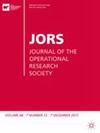An adaptive multi-objective optimal forecast combination and its application for predicting intermittent demand
IF 2.7
4区 管理学
Q2 MANAGEMENT
引用次数: 0
Abstract
AbstractWhile time series forecasting models are generally trained by optimising certain forms of error, the end-user’s forecasting needs in a multi-objective setting can be broader, and often mutually conflicting. A production manager may prioritise high product fill rates and low average inventory resulting from a forecast over just low error. The conflict among multiple objectives is notably worrisome in intermittent demand forecasting, where error-minimising approaches can devalue the practitioner’s objectives. To address such forecasting problems, we propose an Adaptive Multi-objective Optimal Combination (AMOC) of forecasts which incorporates the end-user’s preferences across multiple objectives. We demonstrate the use of AMOC in a real-life application of intermittent demand forecasting for optimising four distinct inventory management objectives using five specialised forecasting methods across single-period and multi-period inventory handling scenarios. Additionally, we conduct a comprehensive experiment on a subset of M5 competition data to exhibit the robustness of the AMOC using 13 diverse forecasting methods and four statistical objectives.Keywords: Time series forecastingmulti-objective optimisationpreference value functionadaptive algorithmforecast combination Disclosure statementNo potential conflict of interest was reported by the authors.Notes1 An older working paper was available at the IIMA Research and Publications department (https://www.iima.ac.in/sites/default/files/rnpfiles/73560124152022-06-04.pdf?cv=1).自适应多目标最优预测组合及其在间歇性需求预测中的应用
摘要虽然时间序列预测模型通常是通过优化某些形式的误差来训练的,但是最终用户在多目标设置中的预测需求可能更广泛,并且经常相互冲突。生产经理可能会优先考虑高产品填充率和低平均库存,这是由于预测而不是低错误。在间歇性需求预测中,多个目标之间的冲突尤其令人担忧,在这种情况下,最小化误差的方法可能会降低从业者的目标。为了解决这些预测问题,我们提出了一种自适应多目标最优组合(AMOC)的预测,它包含了终端用户在多个目标上的偏好。我们演示了AMOC在间歇性需求预测的现实应用中的使用,通过在单期和多期库存处理场景中使用五种专门的预测方法来优化四种不同的库存管理目标。此外,我们使用13种不同的预测方法和4个统计目标对M5竞争数据子集进行了全面的实验,以展示AMOC的稳健性。关键词:时间序列预测多目标优化偏好值函数自适应算法预测组合披露声明作者未报告潜在利益冲突注1 IIMA研究和出版部提供了较旧的工作文件(https://www.iima.ac.in/sites/default/files/rnpfiles/73560124152022-06-04.pdf?cv=1)。
本文章由计算机程序翻译,如有差异,请以英文原文为准。
求助全文
约1分钟内获得全文
求助全文
来源期刊

Journal of the Operational Research Society
管理科学-运筹学与管理科学
CiteScore
6.80
自引率
13.90%
发文量
144
审稿时长
7.3 months
期刊介绍:
JORS is an official journal of the Operational Research Society and publishes original research papers which cover the theory, practice, history or methodology of OR.
 求助内容:
求助内容: 应助结果提醒方式:
应助结果提醒方式:


